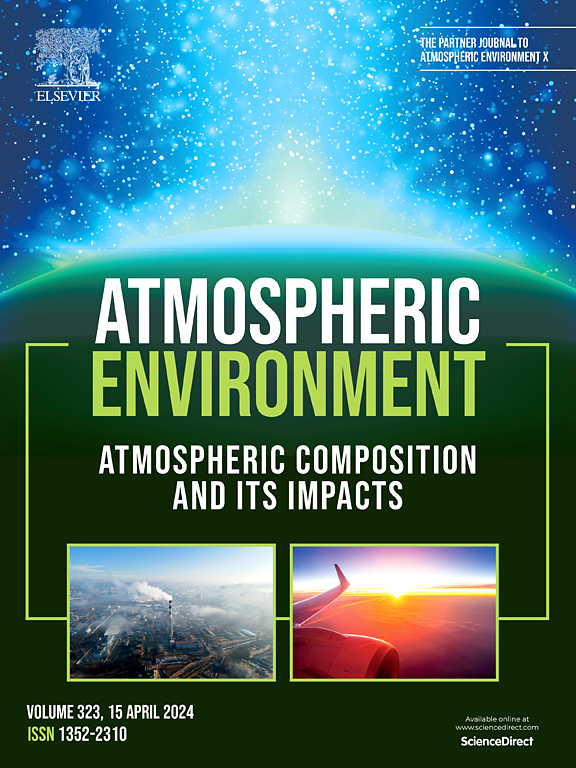Seasonal variations in whole–ecosystem BVOC emissions and ozone fluxes from a tropical rubber tree plantation in China
IF 4.2
2区 环境科学与生态学
Q2 ENVIRONMENTAL SCIENCES
引用次数: 0
Abstract
Biogenic volatile organic compound (BVOC) and O3 fluxes and concentrations, along with environmental variables such as solar radiation and air temperature, were measured in a tropical rubber tree plantation in China from August 2018 to June 2019. The detected BVOC fluxes included five terpenoid compounds, isoprene and four monoterpenes, measured using a gradient (GRA) sampling system deployed on an above canopy flux tower. Isoprene accounted for only 13 % of total terpenoid emissions at this site. The remaining 87 % of total terpenoid emissions were dominated by α-pinene (16 %), camphene (20 %), β-pinene (19 %), and limonene (32 %). Isoprene and monoterpene emission fluxes showed clear diurnal variations, with higher emissions around noon and lower emissions in the morning and late evening. The emission peaks typically occurred several hours after the peak in photosynthetically active radiation (PAR) around noon. Isoprene and monoterpene emissions also varied seasonally. O3 fluxes were negative (downward) and peaked around noon, with the highest fluxes observed in the dry season. BVOC concentrations at the bottom and top levels were higher around noon, and concentrations were higher at the bottom level than at the top level, indicating upward fluxes. O3 concentrations at the bottom and top levels showed clear diurnal variations, with higher values around noon. O3 concentrations at the top level were higher than those at the bottom level. BVOC emissions and ozone flux, along with their concentrations, are correlated with atmospheric conditions including PAR, air temperature (T), and water vapor and appear to be influenced by smoke plumes. The relationships between BVOC emission, ozone flux, atmospheric conditions (represented by S/Q, the ratio of solar scattered radiation to global radiation), and their concentrations and S/Q were investigated. These relationships can be used to better understand and inform strategies for controlling ozone pollution in China and other locations.
中国热带橡胶林全生态系统BVOC排放和臭氧通量的季节变化
2018年8月至2019年6月,在中国热带橡胶林测量了生物源性挥发性有机化合物(BVOC)和O3的通量和浓度,以及太阳辐射和气温等环境变量。检测到的BVOC通量包括5种萜类化合物、异戊二烯和4种单萜类化合物,采用梯度(GRA)采样系统在冠层通量塔上进行测量。异戊二烯仅占该基地总萜排放量的13%。其余87%的萜类化合物主要为α-蒎烯(16%)、莰烯(20%)、β-蒎烯(19%)和柠檬烯(32%)。异戊二烯和单萜烯排放通量日变化明显,中午前后排放量较高,上午和傍晚排放量较低。在正午左右的光合有效辐射(PAR)峰值后数小时,通常会出现辐射峰值。异戊二烯和单萜烯的排放量也随季节变化。O3通量为负(向下),中午前后达到峰值,旱季最大。中午前后,底层和顶层的BVOC浓度均较高,且底层浓度高于顶层,呈上升趋势。底部和顶部的O3浓度呈现明显的日变化,在中午前后较高。顶层O3浓度高于底层O3浓度。BVOC排放和臭氧通量及其浓度与包括PAR、气温(T)和水蒸气在内的大气条件相关,并似乎受到烟羽的影响。研究了BVOC排放、臭氧通量、大气条件(S/Q,即太阳散射辐射与总辐射的比值)及其浓度与S/Q的关系。这些关系可以用来更好地理解和制定控制中国和其他地区臭氧污染的策略。
本文章由计算机程序翻译,如有差异,请以英文原文为准。
求助全文
约1分钟内获得全文
求助全文
来源期刊

Atmospheric Environment
环境科学-环境科学
CiteScore
9.40
自引率
8.00%
发文量
458
审稿时长
53 days
期刊介绍:
Atmospheric Environment has an open access mirror journal Atmospheric Environment: X, sharing the same aims and scope, editorial team, submission system and rigorous peer review.
Atmospheric Environment is the international journal for scientists in different disciplines related to atmospheric composition and its impacts. The journal publishes scientific articles with atmospheric relevance of emissions and depositions of gaseous and particulate compounds, chemical processes and physical effects in the atmosphere, as well as impacts of the changing atmospheric composition on human health, air quality, climate change, and ecosystems.
 求助内容:
求助内容: 应助结果提醒方式:
应助结果提醒方式:


